We hope you enjoy the articles and short stories presented here, and will join Kate in her adventures for many years to come.
Upon request, you will receive an inscribed copy of Kate Tattersall Adventures in China with every donation of $10 or more plus shipping. Please use the Contact Page to provide your shipping address and we will reply with your total.
Drawers were not generally worn during the early 19th century by most British women. It was more convenient to wear long hose, stockings, and layers of petticoats under their skirts. Some women, particularly wealthy ladies who wore the very sheer garments of the Empire dress period, adopted men’s drawers (sometimes known as pantaloons) for modesty purposes. These were close-fitting and crafted of flesh coloured material to create an illusion of nudity under the dress. Women’s underpants were more popular in the New World where they started to be mass produced in cotton. By 1830 women’s drawers, or “trowsers,” were accepted by British women and examples and patterns of versions exist from then. It can be confusing when reading about clothes in those times because sometimes drawers and trousers are underwear, other times outerwear for men. In the 1840 book, The Workwoman’s Guide, patterns and advice is provided on how to craft drawers for everyone; both sexes of all ages, and it is definitely undergarments.
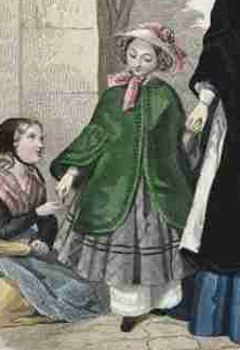
Fashion plate detail, pantalettes, 1847.
“Mrs Kenwigs, too, was quite a lady in her manners, and of a very genteel family, having an uncle who collected a water-rate; besides which distinction, the two eldest of her little girls went twice a week to a dancing school in the neighbourhood, and had flaxen hair, tied with blue ribbons, hanging in luxuriant pigtails down their backs; and wore little white trousers with frills round the ankles — for all of which reasons, and many more equally valid but too numerous to mention, Mrs Kenwigs was considered a very desirable person to know…” Chapter 14, Nicholas Nickleby, by Charles Dickens, originally published as a serial from 1838-39.
Girls wore various forms of pantalettes until their skirts reached their ankles; somewhere between twelve and sixteen years of age depending on the parent’s outlook and the maturity of their daughter (some girls were married at twelve). Pantalettes were generally decorated down by the ankles and meant to be seen. Leglets, a cuff of lace attached by buttons, was a popular and practical way to decorate the exposed part of the legs. By the 1850s the huge belled dresses ladies were wearing (usually requiring crinoline cages) meant something had to be worn, lest the embarrassment that might accompany a fall or gust of wind; even a staircase or climbing in a carriage might reveal too much.
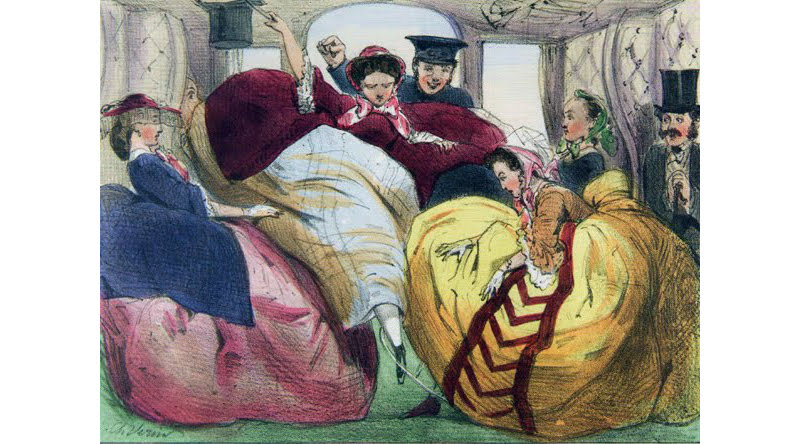
A French ink and watercolour from the 1850s, showing women struggling in a first-class train carriage. The girl in the middle might be about to take an embarrassing tumble. Note that she is grabbing a hat brim cord, these were installed for hat storage in carriages.
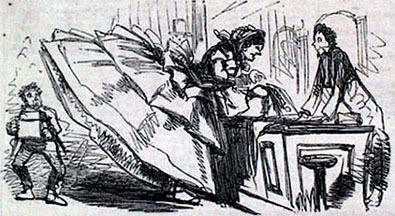
Women who embraced the crinoline fashion craze suffered a great deal of inconvenience in their daily lives and mockery from satirical cartoonists. Another issue for the ladies was warmth, for they had shed layers of petticoats. A great many of the travelling, riding, and walking suits maintained the practical smaller profile with petticoats, and were favoured by many women, Kate Tattersall included. However, to appear at the grand balls or high society social functions, every lady had to possess a few extravagant gowns and, therefore, decent drawers.
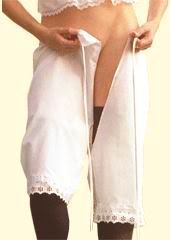
Vintage and Retro by Enchanted Oldies based in Liverpool, U.K., produces Victorian undergarments in poly/cotton blends.
Most drawers for women in the mid 1800s were split leggings and about knee length. Each leg was finished separately and joined together at the waistband only, leaving the crotch seam open, but crafted so there was a bit of an overlap. They usually had a drawstring at the waist and tied or buttoned at the centre back, but sometimes in the front. Drawers were made of various materials, white linen very popular and often trimmed with lace, but plain cotton was the most affordable. Linen held up well in the times of strong lye soaps. It was noted in 1840 that women who rode frequently wore flannel or wash-leather drawers, with or without white calico leglets. For most women, split drawers were a necessity, because with all the layers they couldn’t pull down their drawers to use a chamberpot, much less pull them back up again, particularly when a tight corset was added to the outfit.
The chahut, which began as a rowdy dance for couples in the 1830s and evolved into the cancan by about 1850, may have been one of the reasons little buttons started to be used as an option to hold drawers closed, London usually following the Parisian fashion innovations and trends by about a decade. (The truly risqué dancers wore nothing, and were banned from respectable dance halls.) Many medical men advised against this practise of wearing closed drawers, the belief being women’s nether regions required constant fresh air to prevent dampness and all the dreaded manifestations of hysteria. However, women were wearing trousers on a regular basis, so the doctors were obviously ignored by countless members of the fairer sex who could think for themselves.
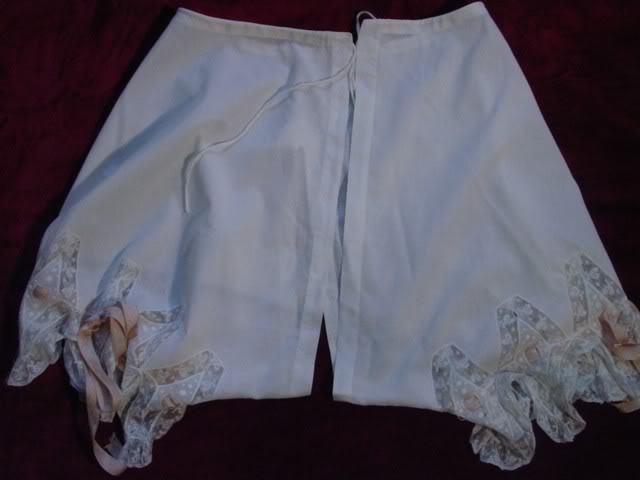
Another influence of the era was the Women’s Emancipation Movement, which included the adoption of “bloomers” starting in the early 1850s, popularized by Amelia Bloomer of New York. Known as “American Dress” and “Reform Costume” by the women who were attempting to have more practical attire accepted in society, combining a form of pantaloons (baggy trousers which tapered to the ankles), and short skirts like youngsters wore. Travellers likened the outfits to similar dress they had seen in the Arabian lands, so to some it was known as “Syrian costume.” Of note, the book I referenced in the second paragraph of this article includes “Turkish Trowsers” for little girls, the pattern looking very much like bloomers, and that was in 1840. The ladies who paraded in public wearing bloomers suffered mockery from newspapers and satirical cartoonists akin to their crinoline opting sisters. However, it was the start of women’s trousers being accepted in society, and by the late 1800s athletic bloomers (more like knickerbockers) were considered quite fashionable and somewhat encouraged for sports and cycling, drawers worn underneath. Obviously ladies did think for themselves, and had garments made to their specifications, adapting costumes and men’s clothes for underwear and outerwear. To be clear, in the Victorian era, bloomers were a type of women’s trousers, not underwear. To read more about Victorian women in trousers click here.
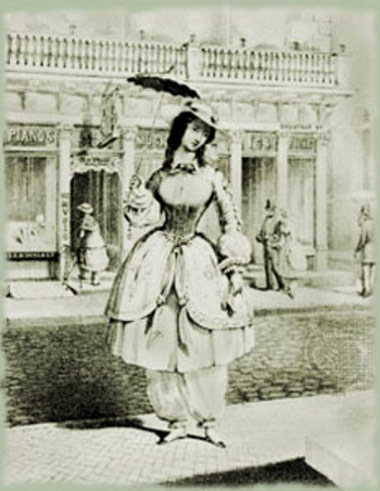
Fashion drawing, early 1850s. She looks lovely, and this would have been an expensive outfit.
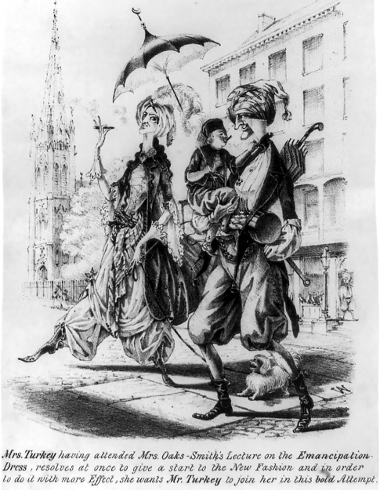
A newspaper cartoon titled “Turks in Gotham” from 1851, it plays up the middle-eastern influence, and makes the characters as ridiculous as possible.
Kate Tattersall did not care for the bloomer fashions, preferring her long skirts and dresses when in society, but she wore breeches (riding pants) on many occasions for practical purposes. (There are examples of women’s breeches made of wool or chamois leather, as part of their riding habits, as early as the 1850s, and became standard by the 1880s.) This probably led Kate to having special under-shorts made. Perhaps these had buttons or a sewn crotch seam? If so, she was a decade ahead of fashion, likely adapting standard split-drawers to achieve her desired garment. (Of course, men’s drawers had buttons, and the somewhat rare women’s pantaloons that went with the Empire dress of the early 1800s did too.) By the 1860s this sort of silk or fine linen under-shorts was available for wealthy ladies at all the best shops, and less expensive cotton versions were mass produced (thanks to the sewing machine) and sold in general stores; short, long, laced, and plain. Split drawers continued to be popular, produced up until the 1920s, ideal for women who still chose to wear corsets. Modern versions of Victorian styled drawers are available for purchase from many sources, made of silk, satin, cotton, linen, polyester, rayon, &c. Today people use the term bloomers for what would have been known as drawers or trowsers, and some retailers market their products as pantalettes.
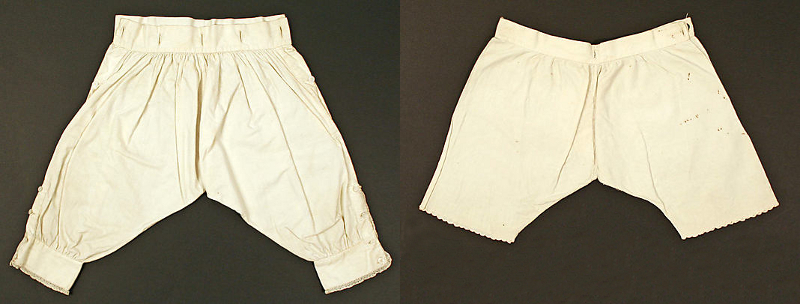
These mid 19th C. examples from the Metropolitan Museum of Art are typical of the mass produced linen and cotton styles that survive in collections today.
Of interest, to Americans in particular, by 1836 there was already a reference to “knit silk drawers and under shirts” in a Treasury Department Circular signed by Comptroller Mr J. Anderson with regards to import fees. These items are listed among many, some men’s, some women’s, some sundries, so there is no way to be certain for which gender they were intended. Probably both, since manufacturers of what was then known as “ready-made clothing” catered to all, and undoubtedly reveals there was an established market for silk undergarments in the U.S. and customers wealthy enough to afford such luxury. How many years import of this nature had existed is currently unknown, but it confirms that it stretched back before the crowning of Queen Victoria.
Conclusion from this series of articles on early Victorian undergarments, Introduction, Part 1, and Part 2; Kate wore a lovely collection of custom silk “unmentionables” most of the time, although she may have worn chamois drawers for riding. While it would have been expensive she probably didn’t give the cost much thought. Today we have all kinds of materials, but during her life there would have been no finer clothing to put next to her skin.
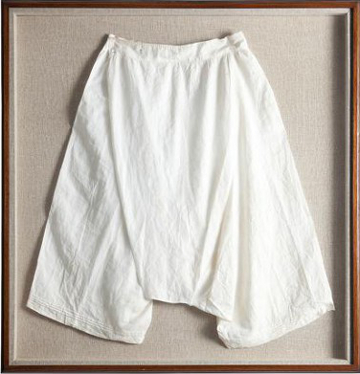
A nice example of Queen Victoria’s silk drawers, sold for £9,375.00 on 1 Nov 2011, Paul Fraser Collectibles. These drawers were made sometime in the 1860s. They appear quite plain, and baggy for the size of the waist.
Note: Pockets were crafted that could be tied into the crotch, suspended front and back by the drawstring of split drawers or from a belt. In the pocket would be inserted a handkerchief or some kind of absorbent wadding. The belt that was worn with straps to hold up stockings could also serve to suspend the absorbent pocket. The first actual patented belted menstrual pad appeared in 1858, known as a Jensen’s catamenial bandage. No doubt Mr. Jensen copied home-made versions to produce a ready-made product for sale in the growing mass produced clothing market.
Trivia: It has been recorded Queen Victoria had fresh, new, hand made, silk undergarments every day of her adult life, so starting around the time she took the throne, 1837. Once removed from her royal body, these garments were cleaned, then embroidered with a crown, the date, and the initials VR, for Victoria Regina, and perhaps VRI (Imperatrix, once she became Empress of India, 1876). Some of her large-sized preserved undergarments are in fact fine linen. It is recorded that she had a 20″ waist when crowned and perhaps a 50″ waist when she died. Waist size is difficult to determine when examining drawers, because they were crafted to tie and overlap, although pairs made with buttoned waists are reliable.

It’s interesting that Queen Victoria’s worn/washed underpants were embroidered after use. Do you know what happened to them? Were they stacked up for posterity? Which makes me wonder – why weren’t they simply burned?
@Kay, Queen Victoria gave away clothes throughout her reign, and a great deal of her garments were stockpiled over the years, and upon her death distributed amongst the Royal Household (undergarments included) and are now in private and public collections. The garments were like new, so burning them would have been a great waste.
I can’t confirm this, but I’ve read that Queen Victoria’s drawers had such large waists because she began wearing her drawers down around her hips, instead of at her waist. She was overweight, certainly, but if what I read is true, she wasn’t quite as large as the waist measurements of her undergarments would indicate.
I’m quite enjoying your articles! It’s lovely to see someone fighting the misinformation that’s so prevalent regarding all things Victorian. I wrote a similar two-part article to clarify the facts about corsets (http://yesterdaysthimble.com/articles/corset-myths-i/). I got tired of hearing people talk about how dangerous and painful corsets were, so I set out to debunk the myths and legends. In any case, thanks again for writing such informative articles! They are much appreciated.
Thank you for your comment Lisha, and for the link to your articles on corsets. I hope people can understand that it was the tight-lacing that was hazardous, not the corsets.
vivir en estos tiempos el que una mujer use una pantaleta esta muy ala antigua, es mejor usar NADA. pero para mi entre mas grandes mejor y mas comodo
I thought that split underwear was worn in the 19th century as it would be very difficult to answer the call of nature with those long skirts and corsets. My grandmother was known to wear them in the 1960’s but I have no idea where she bought them!
I am writing a novel and the story takes place in England in the 1800’s so your information is such a help.
I love finding underwear such as this even now and wear them.
Your website is stock full of everything I have been searching for! Thank you so much for bringing this information out for the world to see. Because I am using, in my head, the images of my own versions of the dresses and undergarments! I have credited you in my book. It is set in the Phantom of the Opera time frame.
I found your article very interesting.
As is Betty Annand, I too am writing a novel circa 1847. Your website has been a godsend.
Awesome blog! Many thanks!
My Mother died in 2011 at 96 and told me she recalled her Mother telling her about wearing split pantaloons and long dresses. They stood over the chamber pot to urinate
I like the old fashions. Drawers would be nice under some clothes.
This is a great article for a project.
Wow, this is just what I was looking for. My search on whether or not women still wore pockets beneath their petticoats during the late Antebellum period and the beginning of the Civil War era led me to here! Great informative article and easily understandable. Thank you!
When British working class women went out to the colonies by ship did they adapt their underwear for living under wagons with men, in the open air without access to conveniences etc?
Hi Mike, those women didn’t have a lot of options. They made most of their own clothes, and for their families. The women wore skirts with several petticoats, or they crafted simple drawers. There are records of some frontier women wearing trousers.
A BRIEF HISTORY OF LADIES UNDERWEAR, By Tim Lambert, Early Women’s Underwear: Ancient Greek women wore a form of bra called an apodesme. Both Roman men and women wore a loincloth or shorts called subligaculum.
Why this was extremely helpful.
Your articles are so fascinating and well-written! I am a huge history buff and I was wondering what your main primary sources are for your information and how you access them? I love how succinct your articles are but sometimes I enjoy analyzing the primary sources for myself!
Thanks Colby. I use Google Advanced Book searches and glean info from sources written during the times. Sadly, I found articles by historians often quoted earlier historians, all of whom made incorrect assumptions based on a single quote. With archives, newspapers, and public domain articles, textbooks, and novels, now being scanned and made available free for all, we are able to study and interpret data for ourselves.
I wonder what feminine hygiene products were used when Aunti flow arrived? How was it made to stay in place … I have a beautiful pair of Madeira linen, Victorian split crotch bloomers with brodere Anglaise lace and that’s all I could think of is “what did they do” those poor ladies …
Hi Julie, the women wore a “menstrual belt” that was crafted rather like a simple strap thong with a pocket sewn in. In the pocket they would place everything from fine cloth, to scrap rags, to thistle down, etc., whatever they could afford and anything that would absorb body fluids.
Hi, I will be an extra in a short film, in the role of a young man who to avoid going to war lives as a lady. The scene is in 1862, Louisiana. I wear a crinoline dress and undergarments.
Thank you very much for such informative and reliable information.
You’re very welcome.
As you have written, there was some resistance to closed-crotch drawers. Intolerant men claimed the cloth in contact with a woman’s vulva aroused her and was therefore scandalous. Nonetheless, affluent women were wearing closed-crotch drawers by the mid-1890s, and women of progressively lesser means followed the fashion. During the first decade of the 20th century, the split (pun intended) was 50-50 or 60-40 (am guessing). But come World War I, the British Army either issued or insisted upon open-crotch drawers, so distaff personnel would do their business as quickly as possible and not absent themselves from duty for a lengthy period. True for signalwomen, drivers, but particularly nurses urgently needed on the wards. Likely the US Army followed suit. By the 1920s, drawers were sold as both open- and closed-crotch versions, the former favored by older women. There followed some decades before going commando became fashionable again.